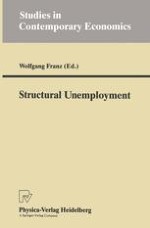
1992 | OriginalPaper | Chapter
A Theoretical and Econometric Analysis of Structural Unemployment in Germany: Reflections on the Beveridge Curve
Authors : Wolfgang Franz, Karin Siebeck
Published in: Structural Unemployment
Publisher: Physica-Verlag HD
Activate our intelligent search to find suitable subject content or patents.
Select sections of text to find matching patents with Artificial Intelligence. powered by
Select sections of text to find additional relevant content using AI-assisted search. powered by
Unemployment in the Federal Republic of Germany has remained at a permanent high level for years. The explanation for this continued lack of jobs has shifted both in the academia and in the public towards considerations which blame “structural factors” as the major source of this problem. The prerequisite for an economic analysis of these presumptions is a theoretical framework which is able both to capture factors which may be viewed as determining structural unemployment and to allow for an empirical test of the relevance of these determinants. The Beveridge curve, i.e., the relation between vacancies and unemployment, is often used as an analytical instrument to identify the extent and the causes of structural unemployment. In recent years several theoretical and empirical studies employing the Beveridge curve have been carried out such as (1987) for Austria, (1988) and (1987) for the Federal Republic of Germany and, (1989), (1985) and (1988) for Great Britain, to name but a few. Most if not all studies of this type wind up with the conclusion that the Beveridge curve has shifted outwards thus indicating a higher degree of malfunctioning of labor markets. In Germany, as in some other countries, this result is also obtained by estimating a disequilibrium macro-model as is shown in the study by (1991).